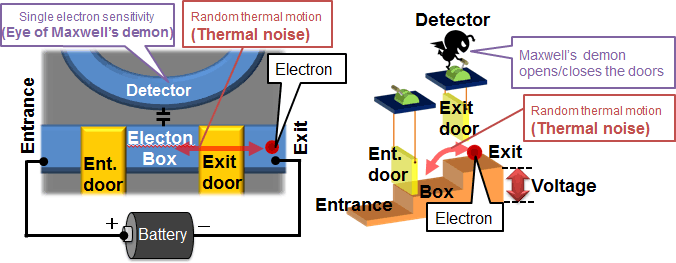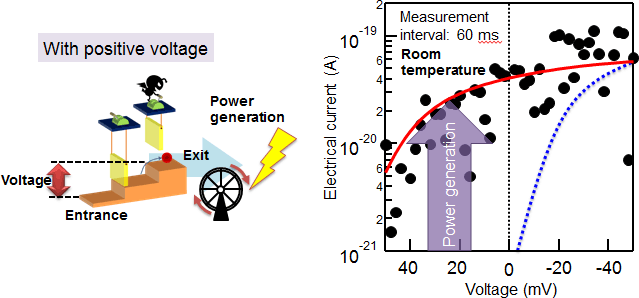Microsoft ends support for Internet Explorer on June 16, 2022.
We recommend using one of the browsers listed below.
- Microsoft Edge(Latest version)
- Mozilla Firefox(Latest version)
- Google Chrome(Latest version)
- Apple Safari(Latest version)
Please contact your browser provider for download and installation instructions.
May 16, 2017
Electrical current generation by sorting thermal noise --Power generation with Maxwell's demon--
Nippon Telegraph and Telephone Corporation (NTT; Head Office:Chiyoda-ku, Tokyo; President and CEO: Hiroo Unoura) has generated an electrical current and power by sorting the random motion of electrons (thermal noise) in transistors*1. In the experiment, the random motion was sorted on the basis of a principle related to a famous thought experiment known as Maxwell's demon*2.
Thermal noise is a random motion of electrons that does not generate electrical currents. However, if the noise can be observed at the single-electron level and if electrons moving in a certain direction can be sorted out from the noise, an electrical current can be generated from the random motion. Maxwell's demon is an entity that can perform the observation and sorting. Achieving the operation of Maxwell's demon was technically challenging because it requires observation and control at the single-electron level.
In the first demonstration of its kind, NTT succeeded in generating an electrical current and power by performing the operation of Maxwell's demon with nanometer-scale silicon transistors. Since Maxwell's demon is related to the lower bound of energy consumption in electrical devices and power generation efficiency in small heat engines, such as biomolecules, we anticipate that this achievement will contribute to create small, energy-efficient electrical devices.
This achievement is reported in Nature Communications in May 16, 2017.
Background
The second law of thermodynamics*3 says that everything eventually becomes random. Thus, we cannot create ordered motion of electrons, or electrical current, from thermal noise without applying power with a power source. Maxwell's demon, an entity thought to violate the second law, has been vigorously discussed among physicists for more than 150 years. The discussions have clarified that Maxwell's demon requires energy in order to use information about the thermal motion of electrons and that it works like a power source. This means that we need a certain amount of energy to obtain 1 bit of information; we can create such an amount of energy at maximum from the information. This notion leads to the concept of information thermodynamics, in which the role of information is treated in the same way as energy is. Since information thermodynamics explains the lower bound of energy consumption in electrical devices and the efficiency of power generation in small heat engines, such as biomolecules, we anticipate that studies in this field will lead to small, energy-efficient electrical devices.
To generate electrical power with Maxwell's demon, we have to achieve three things: observation of electron thermal motion, electron sorting with the obtained information and outputting the sorted electrons that have large energy. Previous experiments have achieved the observation and sorting but not the outputting.
Achievements
We have succeeded in generating electrical current by sorting thermal noise in silicon transistors using a silicon single-electron device*4 (Fig. 1). The electrical current can be output to adjacent electrical devices, which can be regarded as power generation with Maxwell's demon.
Details of measurements and observation
In the experiment, we used an electron box made of silicon. Two nanometer-scale silicon transistors serve as doors that through which electrons can enter and exit the box. By switching the transistor on and off, we can open and close the door between an entrance and the box (entrance door) and the door between the box and an exit (exit door) separately. The number of electrons in the box was observed in real time by measuring the resistance of a nearby nanometer-scale charge detector.
The procedure for the demon's operation is as follows (Fig. 2).
- Open the entrance door and observe random electron motion between the entrance and box.
- Close the door when electrons enter the box.
- Open the exit door and observe random electron motion between the box and exit.
- Close the door when electrons exit the box.
By repeating this procedure, we can move electrons from the entrance to exit. The sorted electrons can specifically climb up the voltage across the entrance and exit (Fig. 3).
 Fig. 1: Device structure
Fig. 1: Device structure
 Fig. 2: Operation of Maxwell's demon
Fig. 2: Operation of Maxwell's demon
- On the left is a schematic illustration of power generation with Maxwell's demon. Maxwell's demon sorts electrons with large energy and outputs them. The energy can be utilized as electrical power as depicted. The right graph shows the electrical current (in the direction corresponding to electron motion from the entrance to the exit) as a function of the voltage. The voltage represents the height of the exit relative to that of the entrance (when the exit is higher than the entrance, the voltage is positive). The dotted blue line is the expected electrical current without Maxwell's demon. In this situation, electrons flow from the entrance to the exit only when the voltage is negative. On the other hand, with Maxwell's demon, electrons are expected to flow from the entrance to the exit even when the voltage is positive, which is shown by the red line. The experimentally obtained electrical currents, plotted as black circles, are similar to the expected value with Maxwell's demon. When the voltage is positive, electrons climb up the voltage and Maxwell's demon generates electrical power as illustrated on the right.
 Fig. 3: Power generation with Maxwell's demon
Fig. 3: Power generation with Maxwell's demon
Technical features
The experiment requires a detector that has single-electron sensitivity and doors that open and close precisely at the single-electron level. We have been studied single-electron detection and manipulation using nanometer-scale silicon transistors for more than two decades and have experience in creating nanometer-sized charge detectors with single-electron sensitivity and transistors without leakage, which can be used as the doors for the demon's operation. In this study, we integrated those functionalities in one silicon single-electron device and achieved an operation of Maxwell's demon that sorts thermal noise to generate electrical power.
Outlook
The results are related to the lower bound of energy consumption in electrical devices and efficiency of small heat engines. Biomolecules, e.g., molecular motors*5, are thought to perform their operation at proper timings to achieve high energy-to-power conversion efficiency. This efficient process in biomolecules is probably related to the operation of Maxwell's demon. We will attempt to make an electrical device that mimics their high efficiency.
Publication information
Kensaku Chida, Desai Samarth, Katsuhiko Nishiguchi, and Akira Fujiwara
"Power generator driven by Maxwell's demon"
Nature Communications (2017).
Glossary
*1Transistor
Semiconductor devices amplify or switch an electrical signal on and off. In this work, we used field-effect transistors, in which electric current flowing in silicon is turned on or off by applying a voltage to a gate electrode. The gate electrode is formed on silicon via an insulator consisting of silicon dioxide.
*2Maxwell's demon
An entity that can perform observation and operation at the level of thermal motion. It first appeared in J. C. Maxwell's famous thought experiments around 1867.
*3Second-law of thermodynamics
The law related to the direction of natural processes. It states that heat flows from hot to cold, uninformed objects become uniform, and ordered objects become disordered. The opposite process requires energy input from outside.
*4Single-electron device
An electrical device that enables us to detect and manipulate one electron at a time.
*5Molecular motor
Biomolecules generate mechanical motion from various energy sources in a cell, which is essential in biochemical reactions such as those associated with metabolism and muscle movement. Their high efficiency of energy conversion is thought to be achieved by observing the random motion of molecules caused by thermal noise like Maxwell's demon.
Contact information
Nippon Telegraph and Telephone Corporation
Science and Core Technology Laboratory Group, Public Relations
a-info@lab.ntt.co.jp
Information is current as of the date of issue of the individual press release.
Please be advised that information may be outdated after that point.
NTT STORY
WEB media that thinks about the future with NTT











